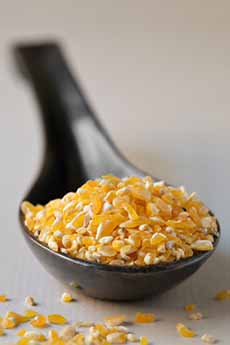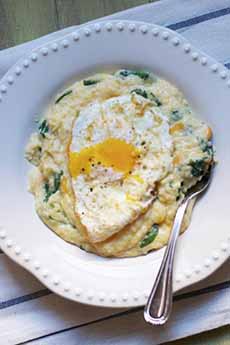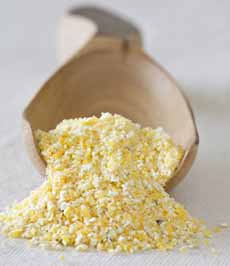Grits Are Not Just A Side At Breakfast (& More About Grits)
|
|
Three-quarters of grits purchased in the U.S. are sold in the South; the area stretching from Virginia to Texas is sometimes referred to as the “grits belt.” This tip is for everyone who lives outside of it. But before we dig in, we’ve got to plug the finest grits money can buy, from AnsonMills.com, producer of heritage, organic grits and other fine grains. Your friends who cook will appreciate a bag. There are delicious recipes on the website, too. If you like cooked cereal or polenta, add grits to your lineup. And enjoy them at all three meals. The difference between grits and polenta is below. Grits casserole is another alternative: Combine grits with any ingredients (bell pepper, onions, mushrooms, other vegetables, sausage or other meat including crumbled leftover burgers and seasonings) and bake at 350°F for 35 minutes. We like to think of polenta as “Italian grits” and grits as “America polenta,” but, based on local cuisines, the are served in slightly different ways. Polenta is not served as a breakfast cereal, for example. And, the types of corn used in the two countries differ. Most American grits are ground from dent corn; most Italian polenta is made from flint corn, which holds its texture better. Thus, American grits can cook up soft, like cream of wheat, while polenta can cook up more toothsome. Grits are corn kernels that are soaked in lye or other alkaline solution to remove the casing. At this point, they are known as hominy; hence the term, hominy grits. The hominy is left to harden and then is ground to the texture of tiny pellets, the “grits.” Grits are boiled with water into a porridge similar to cream of wheat. Grits are of Native American origin, but our modern word comes from the Old English “grytt,” meaning coarse meal. Polenta is coarsely-ground yellow corn, also known as cornmeal, that is slowly cooked with milk/cream, stock or water. A staple in Northern Italy, it is called cornmeal mush in the U.S. It can be served soft like grits with a sauce (mushroom ragu is our favorite) or grated cheese; or can be set into a block shape, then sliced and grilled or pan fried. Polenta can be enjoyed plain, with a sauce (tomato sauce is traditional), or topped with fish, meat, pasta sauce or vegetables. As with grits, polenta can be served sweet or savory. HOW ABOUT MASA? To add a third variable, there is masa, also called hominy: maize kernels that are dried and treated with a solution of calcium hydroxide, an alkaline solution also called slaked lime and wood ash. This process, which loosens the hulls so they can more easily be separated from the kernels,* is called nixtamalization. Died and ground, the kernels are called masa harina, which is used to make arepas, tamales, tortillas, among other Latin American dishes including a chocolate pudding. It is also the base of corn chips, which were originally made (in Los Angeles), by cutting and frying leftover tortillas. *In addition, the process softens the corn. As a side benefit, the alkaline solution reacts with the corn so that the nutrient niacin can be more easily assimilated by the digestive tract. |
|
|
|
||







